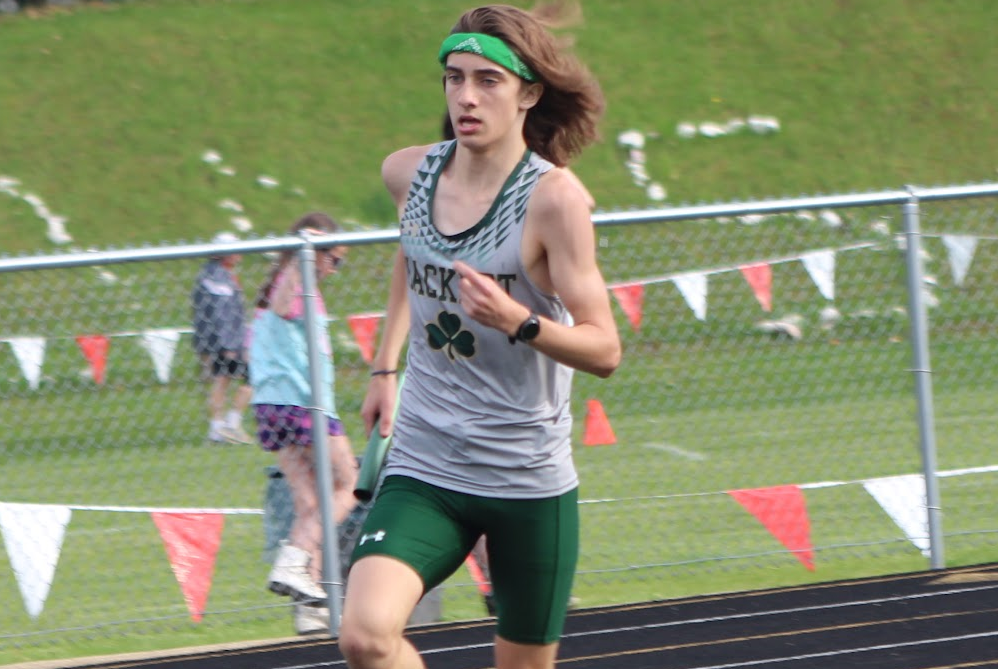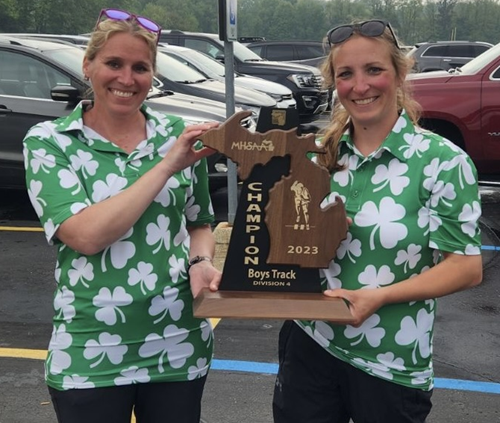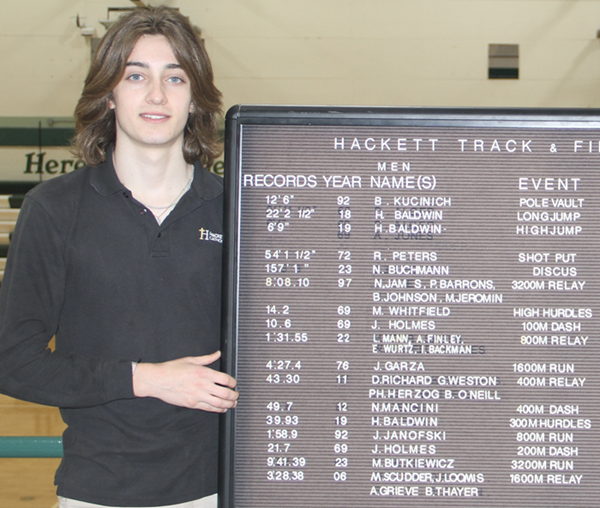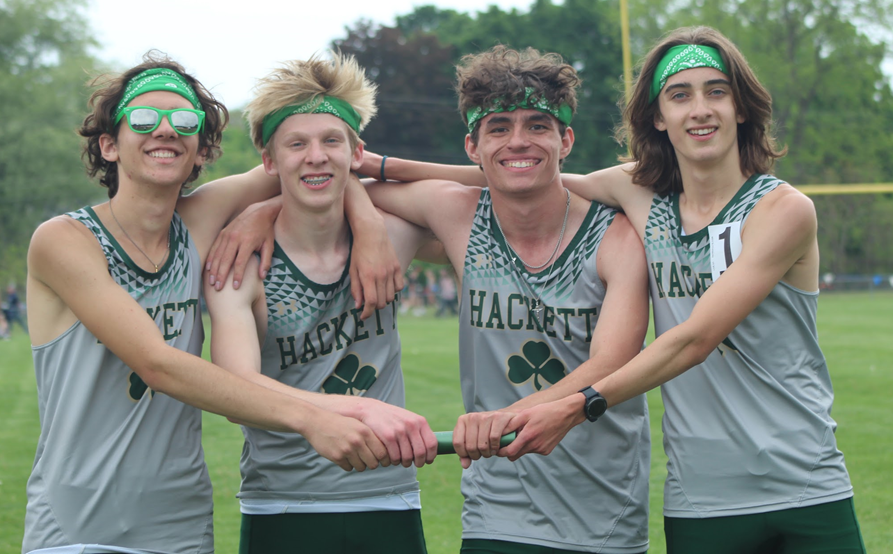
Track Gaining Speed Toward Future with Electronic Starting Devices
By
Steve Vedder
Special for MHSAA.com
May 23, 2023
Aubrey Greenfield thinks it might be the perfect time to reevaluate 130 years of tradition.
For a number of reasons, from technical to personal, the Oxford senior sprinter believes it makes sense for the crack of a starting pistol to be eliminated from high school track meets.
Because track meets would benefit in various ways from lowering costs to easier setup at meets to the human factor of competitors not having to flinch at the crack of a pistol shot, Greenfield believes the sport has a chance to embrace new technology – electronic starting devices (ESD).
In essence, an ESD replaces the starting pistol with a light flash, tone sound or both to begin a race.
"High school sports should put the athlete first," Greenfield said. "We should promote sports, and eliminating starting pistols promotes health in terms of PTSD or trauma for athletes and spectators and that would be good. I would like to think people would say that's a good idea."
In fact, Greenfield would go as far as to say if there was not an implementation of electronic starting devices, many of her teammates would have considered giving up the sport.
"If it's something that helps us compete safely, we're all for it," she said.
Greenfield's opinion apparently is spreading. Michigan High School Athletic Association senior assistant director Cody Inglis said the use of ESD makes it both affordable for meet starters and sensible for athletes and fans to rethink the use of starting pistols. While the MHSAA is not mandating electronic starting devices, it does promote the use of what Inglis calls "emerging technology." He notes that ESD are becoming the norm for organizations such as USA Track & Field, the NCAA and an increasing number of high schools.
 "I think we have to embrace new technology, and we think this will be something that takes hold," Inglis said.
"I think we have to embrace new technology, and we think this will be something that takes hold," Inglis said.
A key part of embracing ESD is the human element. The tragic Oxford High School shooting Nov. 30, 2021, that took the lives of four students while injuring seven others should not be relived even for a fleeting instance at a high school sporting event. Oxford athletic director Tony DeMare said the school began using ESD at every meet, including the MHSAA Lower Peninsula Division 1 Finals last June. He said that decision was embraced by virtually all schools Oxford encountered.
"We were very convinced that the alternative (of ESD) would promote a healthy attitude," DeMare said. "We were overwhelmed with the positive response. If a school was on the fence about it or might not be for it, I think we've started to see the tide turn in favor of people willing to listen and learn about electronic starting devices."
Inglis said the MHSAA is acutely aware of what the crack of a starting pistol can mean to athletes and fans.
"It's unimaginable what Oxford went through, and this is a small way we can help," he said. "We look at a (starting pistol) and think, ‘Could we do something else?’ It's a way of helping to solve a problem."
Over the last several years, the MHSAA has embraced finding an alternative to starting pistols. Inglis noted the discussion started with the cost and diminishing availability of 32-caliber ammunition that meet starters use. A box of ammunition, if it can be found, is around $75 a box.
In addition to cost, there is potential damage from excessive exposure to 150-plus decibels of sound generated by the traditional 32-caliber blanks. Medical studies show damage to ears caused by decibel levels above 120 dB.
The tragedy at Oxford accelerated the conversation.
Inglis said the cost of ESD can be likened to a school sinking money into artificial surfaces at football fields. Yes, there is a great cost at first, but over time money is ultimately saved. An ESD system itself ranges between $200 and $500. Speakers also may need to be purchased, but with ESD starting events like the 800 and 1,600-meter relays positioned near the outside lanes 8, 7, 6 and 5 would result in improved hearing by athletes at the start of a race.
There is one challenge with ESD that track administrators are working to overcome – lighting conditions that lessen the ability to see the ESD’s LED light or strobe when the button is pressed by a starter to begin a race. But that vision difficulty resulting from clear blue skies and backgrounds of setting suns can be substantially improved by incorporating a black background with an ESD – something as simple as a starter holding up black cardboard behind the lighting mechanism at the start of an event.
Inglis said when all factors are considered, the use of ESD makes sense.
 "With the climate we live in nowadays, no lookalike guns is good," he said. "We're not mandating this. But people are saying this is affordable."
"With the climate we live in nowadays, no lookalike guns is good," he said. "We're not mandating this. But people are saying this is affordable."
While switching to ESD would break 130 years of tradition, the timing could be a step forward, said Jeff Hollobaugh, co-author of the book "The Fleet Feet of Spring: Michigan's High School State Championships in Track & Field." He said while no definitive answer is possible, it's likely starting pistols were used at the inaugural state meet at the Jackson Fairgounds in 1895. The meet, which included events like tossing a 16-pound shot put, bike races and a 100-meter sprint, was sponsored by the Michigan Interscholastic Athletic Association (a predecessor to the MHSAA) and comprised mostly of the state's larger schools.
Hollobaugh's sentiments echo what many involved in today's high school track & field believe in terms of making a transition from starting pistols to electronic starting devices.
"It's a change, not necessarily good or bad, just different," he said. "It's not a drastic change, but it will take some getting used to. But it is the future. In the end, we'll all be fine."
DeMare believes the future of high school track will definitely include ESD.
"Our desire is that the practicality and sensibility of this will overcome the alternative," he said. "I think we'll see the automation and electronics taking hold of certain elements in track, and people will embrace it."
PHOTOS (Top) Runners watch official Bertha Smiley as they prepare to begin a race during last season's Lower Peninsula Division 1 Finals at Rockford. (Middle) An electronic starting device provided by VS Athletics was used to start those races. (Below) Smiley sets to begin an event. (Photos provided by David Kuderka/VS Athletics.)

Hackett on Track to Roll Again with Distance Ace Among Those Leading Charge
By
Pam Shebest
Special for MHSAA.com
March 12, 2024
KALAMAZOO — After breaking one track record as a freshman, Marek Butkiewicz already has his eyes on two more.
 Not bad for a runner who did not even plan to run track during his years at Hackett Catholic Prep, a surprise to co-coach Shelly Germinder.
Not bad for a runner who did not even plan to run track during his years at Hackett Catholic Prep, a surprise to co-coach Shelly Germinder.
“I had heard plenty about him from some of the ultras (marathons) and different other races he had done,” Germinder said. "His commitment to the sport came through before we ever laid eyes on who he was. We knew he was going to be an asset to us.”
The current sophomore was not so sure.
“At the end of cross country (freshman year), I didn’t even think I wanted to do track,” Butkiewicz said. “Then I did it and it was ‘This is kind of fun.’
“I was good at it. I honestly didn’t have any desire going into (track season), and then I ran a couple fast times and I thought, ‘I can actually do this.’”
Butkiewicz said his freshman cross country season in 2022 was the first time he really took running seriously, and his interest was boosted when he ran a 17:31 at the Kalamazoo Christian Invitational.
“I was super happy to get the freshman record there,” he said.
This past season, Butkiewicz shattered Hackett’s sophomore cross country record, running a personal best 16:12.2 at the MHSAA Lower Peninsula Division 4 Final, demolishing the record set by Bryan Martin (16:56) in 2000.
That record also has special meaning to Germinder. Martin is her brother.
 The Irish finished in third place at the Final last fall, one point behind Holland Calvary Christian.
The Irish finished in third place at the Final last fall, one point behind Holland Calvary Christian.
With the start of the spring sports season this week, the Hackett boys are hoping to make it three Finals track & field titles in a row and five over six years.
Last year’s boys team made it a sweep, winning the Southwestern Athletic Conference, Regionals, MHSAA Finals and Michigan Interscholastic Track Coaches Association (MITCA) Team State Finals.
The boys and girls teams also earned MITCA Division 4 academic awards, the girls with a cumulative 3.986 GPA and the boys with a 3.909 GPA.
This year’s team has grown from a combined 54 athletes last year to 64 with 38 boys and 26 girls.
“I think the students as a whole are seeing the successes of the team, but I also think it’s some of the flexibility we have in our sport,” Germinder said. “We know there are kids who want a dual sport and want to be involved in other things, and we want that for them, too.
“In a small school, we can’t be successful if we don’t have kids involved in multiple sports because there just aren’t enough bodies.”
Co-coach Charissa Dean said this year’s boys team will have a different look.
“We lost Liam (Mann), who was a really strong sprinter, and he left some big shoes to fill,” she said. “We have a nice nest egg of freshmen and sophomores.
“We had a junior (Gabe Oeurn) last year who is coming into his own, if you look at his track record from freshman to sophomore to junior. Last year, we had Sam Finley who was a freshman, and a sophomore (Jude Coffman) who was first time out.”
Lofty goals
Butkiewicz’s goal is to break his own school 3,200-meter record plus the 1,600-meter record, currently held by Jose Garza (4:27.4 set in 1976).
He’s pursuing a 9.25 in the 3,200 and 4.20 in the 1,600, while his long-term goal is breaking four minutes, hopefully running at a Division I university.
“His dedication, his commitment,” Germinder said. “You can’t teach that. That’s something he does on his own that comes from within. Snow, rain, whatever it is, he’s out there running, no matter what.”
The sophomore said he had no clue about records when he was a freshman, but after turning in a 10:37 in his first 3,200, then 10:05 followed by a 10 flat, he realized a record was in reach.
Butkiewicz credits his dedication for his success.
“I put in hundreds of miles a month, thousands a year, just into grinding and working toward goals,” he said. “I’ll shoot for 40-45 (miles) in-season. Offseason, when I’m building my aerobic base, I want 50 and upwards.”
As a freshman, he found a running buddy in then-junior Gavin Sehy.
“He was the fastest for the past two years and I was a little ahead of him, so we just stuck with each other and trained together,” Butkiewicz said. “Over the winter we started doing a couple miles together.”
 Sehy, who is headed to Southwestern Michigan College in the fall, is shooting to break the school’s 800 record plus the 3,200 running with Nick Doerr, Alex Dumont and Butkiewicz.
Sehy, who is headed to Southwestern Michigan College in the fall, is shooting to break the school’s 800 record plus the 3,200 running with Nick Doerr, Alex Dumont and Butkiewicz.
Sehy was also a running buddy in cross country, finishing second on the team at 16:21.
“(Sehy) always had the potential, but it wasn’t until Marek came along that he started doing that training in the summer,” Dean said. “It has made a massive difference.”
Sehy and Butkiewicz competed in two ultramarathons (more than 26.2 miles) over the summer.
“I had never ran a marathon before, but somehow Marek convinced me to run 38 miles at Kettle Moraine State Forest (Wisconsin),” Sehy said. “And I did. Later in the summer, I ran 50 in Holly, Michigan.”
In the Wisconsin ultra, Butkiewicz was trying to finish the 100-mile run with Sehy pacing him for about 40 miles.
“I ended dropping at mile 75 because of some hip issues but he kept going and finished it,” Butkiewicz said. “The second one in Holly, I was doing 100 miles and he was doing 50, so we pretty much ran together for the first 50.”
Sehy said the two share the same mentality, which makes it easy to have a training buddy.
“We both really want it so bad, and we’re not afraid to do crazy things to get it,” he said. “Last year, during track, we needed to get some more miles in but just ran out of time during the week, so Sunday night we were out running 18 miles until after the sun went down out in the forest.”
Germinder said Sehy has noted he needs to have another runner to really push him.
“That’s one of the really beautiful things about the relationship they have,” she said. “It’s a healthy competition between them, but they want what’s best for each other, too.”
Butkiewicz lives near a land preserve where the two do much of their training, no matter what the weather, and they make it fun, jumping icy puddles and eating berries along the way.
“The coldest day of the year we ran with no shirts just because we could,” Sehy laughed.
When Sehy isn’t available to train, “I’ve been training a lot with Sean Siems; he’s a sophomore, a huge rising talent,” Butkiewicz said.
New year, new leaders
This year’s team will have a different look.
“We lost Liam and Bryce Brown and Nathan Buchmann (discus and only individual Finals champ),” Sehy said. “It’s tough to lose your best guys, but I think we have so much depth on this team, I think we’ll be all right.”
Just two weeks into the young season, Hackett will be on spring break, so many of the athletes pushed the coaches to schedule a meet before then.
 They found one in the Onsted Early Bird Meet on March 20.
They found one in the Onsted Early Bird Meet on March 20.
“They want to see where they are going into spring break to know, is there extra work we need to do during spring break,” Germinder said. “Having a competition will tell them where they’re at.
“If you do nothing (over spring break), then you’re starting all over again. I think a lot of our athletes recognize that and know they have to work a little more.”
Besides Butkiewicz and Sehy, leaders on the team include pole vaulters/sprinters Jack Prom and Lauren Wild.
“Keegan Gallagher is our biggest cheerleader and keeps the team in good spirits,” Germinder added. “He brings something that isn’t just on the track.”
With such large numbers, “If they’re not competing, we like to take them with us on the bus anyway,” Dean said. “They can help support their teammates, they can run a stopwatch, they can take video of the relay handoffs so we can go back and look at it later.”
In spite of the success on the track or in the field, Germinder said she is most proud of the athletes as people.
“With that leadership comes responsibility of good sportsmanship, how they’re interacting with other teams on the line,” she said. “I love watching our boys praying together with other teams before they’re getting ready to run. Or shaking hands before or after, especially sprinting events. It says a lot about who we are.”
 Pam Shebest served as a sportswriter at the Kalamazoo Gazette from 1985-2009 after 11 years part-time with the Gazette while teaching French and English at White Pigeon High School. She can be reached at [email protected] with story ideas for Calhoun, Kalamazoo and Van Buren counties.
Pam Shebest served as a sportswriter at the Kalamazoo Gazette from 1985-2009 after 11 years part-time with the Gazette while teaching French and English at White Pigeon High School. She can be reached at [email protected] with story ideas for Calhoun, Kalamazoo and Van Buren counties.
PHOTOS (Top) Kalamazoo Hackett Catholic Prep’s Marek Butkiewicz rounds a curve during a race last season. (2) Butkiewicz shows the school record board, including his 3,200 entry earned last season. (3) Hackett track coaches Charissa Dean, left, and Shelly Germinder hold up last season’s MHSAA Finals championship trophy. (4) The Hackett 3,200 relay, from left: Gavin Sehy, Alex Dumont, Nick Doerr and Butkiewicz. (Action, coaches and relay photos courtesy of the Kalamazoo Hackett Catholic Prep boys track & field program; record board photo by Pam Shebest.)

